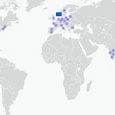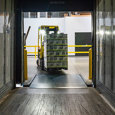Now that we’re over halfway through the year, we decided to check in with our global procurement team to get a pulse on where supply chains are at and what tactics businesses should arm themselves with for their supply chains. We talked to Protolabs Director of Global Procurement Bernadine Henderson and her team members Erik Austin, Tami Netz, and Jordan Stevens to get the latest supply chain scoop.
Do you think we’re past COVID and other Black Swan Events?
Henderson: I’m at the point that I wonder if there will ever be a day without some sort of event! {insert chuckle}
Netz: I think we are past COVID, unless a new variant develops. For resins, lead times overall have returned to pre-COVID levels. There are still many factors to watch for through the end of 2023. Political unrest worldwide, the looming threat of a recession, weather occurrences—these all impact supply.
Austin: Agree with Tami on the COVID front. Metals inventories and lead times are back to normal. China and Russia play a big part in the worldwide metals supply, so there are concerns around how future events could affect the market.
Henderson: I completely agree, it is imperative that we in sourcing expect and plan for future events, because if we have learned anything, something will happen.
Stevens: From a logistics standpoint, we are starting to come back to pre-covid times with overall supplier performance. That being said, there is always a chance with distribution in logistics regarding weather and beyond. Currently the biggest distribution threat could be a UPS strike taking place at the end of this month (July), which will really impact overall U.S. domestic shipping.
How can businesses protect themselves from inevitable supply chain disruptions?
Netz: Identify alternative materials upfront in the event that supply is impacted. Regularly review safety stock levels to maintain more or less inventory.
Austin: Bring secondary/tertiary suppliers online if possible to add another source of supply.
Stevens: Build good working relationships with other suppliers in case you need to move more volume through them.
Henderson: We also need our suppliers to be doing these same activities. One broken link in the supply chain, even if it is the cheapest material or part, has the potential to cause some serious disruptions and delays.

Building an agile supply chain helps minimize disruption and delays in business.
What are your thoughts on just-in-time manufacturing (always having the right quantity on-hand to maintain production) versus building a reserve inventory?
Netz: From my experience, this only works in very stable and consistent manufacturing environments (e.g. we build 100 units per day every day). Even under these conditions, you can still experience a rogue quality issue that can bring manufacturing to a grinding halt. Even in the most stable of manufacturing environments, some level of safety stock is needed.
Henderson: Spot on. In theory it’s a great strategy, but it also only truly exists if your suppliers are local or regional. The further away the source of supply is located, the longer it takes to replenish inventory, and the more safety stock (or reserve inventory) is needed.
What internal processes should companies have in place to help monitor and improve agility?
Netz: I think a robust supplier quality system is important. The quality of any business’s product starts with quality parts.
Austin: In addition, make sure there is a good process in place to review and update inventory levels on a regular basis to allow for agility.
What are some of the perks of offshoring and “friendshoring”?
Henderson: Friendshoring is a relatively new term for us, as we all started our careers offshoring to low-cost countries. Friendshoring is moving our supply chains away from countries with geopolitical unrest to “friendly” countries that are potentially closer geographically. The challenge is that the reason we went offshore to those countries in the first place is that there was an economic advantage.
At a high level, the biggest perk to offshore is low material prices. There is also an infrastructure already in place in these countries due to years and years of offshoring.
The perks of friendshoring are around reduced inventories and logistics. Reduced transit times allow for less inventory to be carried and lower shipping costs, not to mention a potential for less taxes, tariffs, and duties.
Depending on the industry, the challenge is the time it takes to move supply chains from offshore to friendlier shores. In my opinion, this will take years because material costs will be higher and there will be a large investment to move or start up manufacturing in new locations.
What do you think the future of supply chains will look like? Where do you see things trending?
Netz: If artificial intelligence continues to get the focus it has been getting lately, I think the supply chain is the perfect place for it—particularly forecasting. I also think there is more interest in supplier portals and inventory management systems maintained by suppliers.

If you have any issues getting your guide, click here to download.

Full Supply Chain Resilience Report
This excerpt is part of our larger Supply Chain Resilience Report. Download a free copy
Download Full Report







